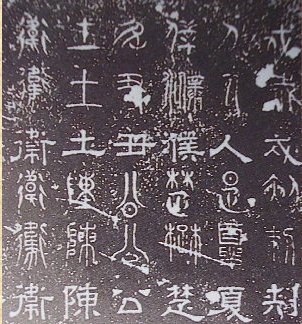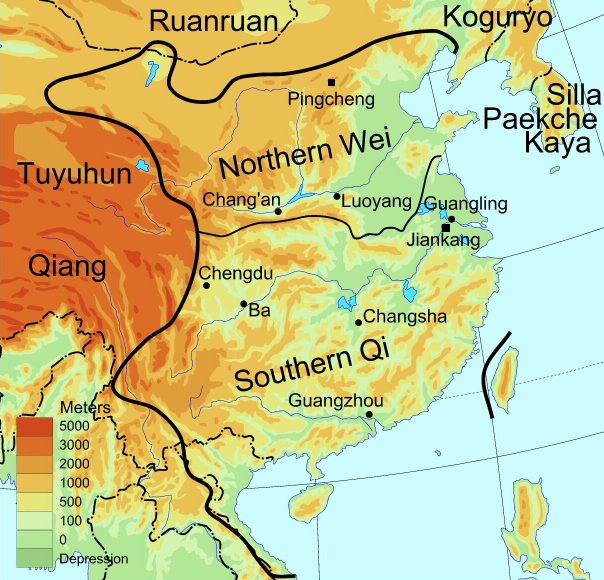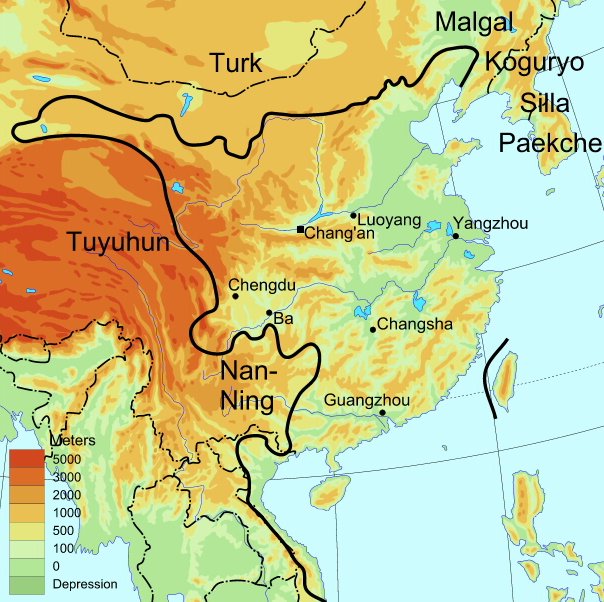
Wei & Jin Dynasties
Wei Dynasty (220-265)
The
Three Kingdoms Period included Wei, Su, and Wu at the same time. Among them, Wei
was playing the big role. Li Style was still used at the beginning of Wei. The
most famous calligraphers at this time were Zhong Yao ( 鍾 繇 ) , Wei Guan ( 衛 瓘 ),
and Han-Dan Tsuen ( 邯 鄲 淳
).
Jin Dynasty (West Jin 265-316, East Jin 317-420)
Just
30 years after the West Jin was established, 16 countries in northern China appeared to
claim each of their own territories. The Sima family (the emperor of Jin) had to
move to the south of the Long River. Calligraphy achieved the best in the
history at this time.
Chinese
calligraphy theories published during this period included:
·
Wei Heng's ( 衛 恆 ) Calligraphy Postures
of Four Styles ( 四 體 書 勢 ) discussed the beauty of calligraphy as an art.
·
Madame Wei's ( 衛 夫 人 )
Map
of Strokes Disposition ( 筆 陣 圖
) proposed the theory of flow and law of calligraphy. She also emphasized the
importance of brush, ink, and ink stone. Seven methods of holding the brush were
summarized and the effects were discussed.
· Wang Hsi-Chih’s ( 王 羲 之 ) Discussion on Calligraphy ( 書 論 )
Calligraphy
Masters in the Wei & Jin Dynasties
· Han-Dan Tsuen 邯 鄲 淳 (?-?): He was good at all scripts. It's said "San Ti Shu Jing 三 體 石 經" elected by the side of Xi Ping Thu Jing was done by him.

Each character is written in 3 styles.
·
Wang Shuen 王 珣 (349-400):
Grandson of Wang Dao who was cousin of Wang Hsi-Chih.
·
Wei Ji
衛 覬 (aka Wei Bo Ru):
Good at all scripts. He once imitated Han-Dan Tsuen's "Gu Wen Som Shu"
but Han-Dan Tsuen couldn't distinguish it from his own.
· Zhong Yao 鍾 繇 (151-230): Studied calligraphy from Liu De-Sheng. People viewed his calligraphy as “swan traveling in the sky, wild goose playing in the sea". He was peered with Zhang Chih ( 張 芝 ) and referred to as “Zhong Zhang”. He was also peered with Wang Hsi-Chih and referred to as “Zhong Wang”. Emperor Liang Wu Di said there were 12 sets of mind levels with extraordinary wonders within his work.
·
Wei Dan 韋 誕 (179-253):
Studied Han-Dan Tsuen's Zuan Style and Zhang Chih's Tsao Style. He was good at
writing on horizontal inscribing boards. Most of the boards of the Wei Dynasty
were done by him.
· Huan Xian 皇 象 (?-?): He was good at Li, Shiao Zuan, and Zhang Tsao styles. His Li Shu was powerful and graceful. His Zuan Shu was exquisite. His studied Tsao Shu from Du Du and was stable and delighted.
· Wei Guan 衛 瓘 (220-291): He and So Jim both learned from Zhang Chih. They say Wei Guan got the bone and So Jim got the muscle.
·
Suo Jin 索 靖 (239-303):
He was grandson of Zhang Chih's sister. He was good at Zhang Tsao and Tsao
Style. He studied from Wei Dan. His calligraphy was more precipitous than his
teacher's.
·
Wei Heng 衛 恆 (252-291):
His book "Si Ti Shu Shu 四 體 書 勢" was
very important in calligraphy theory. He and his father, Wei Guan, were both
killed by the King of Tsu. His daughter, Madame Wei ( 衛 夫 人 ), was the
teacher of Wang Hsi-Chih
·
Madame
Wei (272-349): Her maiden name was Wei and given name was Shuo.
She was the teacher of Wang Hsi-Chih. It's said that she wrote "Bi Zhen Tu
筆 陣 圖" which was an important calligraphy theory
book. She is the most renowned woman calligrapher in Chinese history.
·
Wang Hsi-Chih (Pinyin: Wang Xizhi) 王羲之 (303-361): He earned the
titles of the Calligrapher-Sage ( 書聖
)
and The Dragon of Hsin Shu.
|
|
快雪時晴帖
(Click for Complete Large Pictures)
![]()
Lan Ting Prologue 蘭 亭 集 序
|
·
Wang Jing-He 王 敬 和 (323-358):
Wang Dao's calligraphy was famous at his time. Wang Jing-He was the most famous
among Wang Dao's sons.
·
Wang Hsian-Chih
王 獻 之 (344-386):
The 7th son of Wang Hsi-Chih. He studied his father's calligraphy earlier and
studied Zhang Chih's calligraphy later. He reformed bravely. His style was
brilliant and heroic.
North Dynasty (386-577), South Dynasty (420-589), and Sui Dynasty (581-618)

South & North Dynasties' Territories |

Sui Dynasty Territory |
The
South and North Dynasties were also full of high achievements. There were a lot
of tablets of North Wei (386-534) in Kai Style. The most famous works were
“Lung Men Er Thu Pin 龍 門 二 十 品” with many tablets
at a Buddhist place called Lung Men of which twenty of them were the best.
After
the royal family of the Jin Dynasty immigrated to south of the Long River, China
became two independent countries, south and north. Both southern and northern
countries were divided into 4 or 5 dynasties. This was the longest time of split
and chaos in Chinese history. Calligraphy achieved a high level despite of the
political unrest. Two calligraphy schools were formed during this time: the Te
School ( 帖 學 ) and the Bei School ( 碑 學 ).
(“Te” usually means writings works on paper; “Bei” means works on
monuments or tablets and were generally considered the styles with more strength
and energy.) The South Dynasty inherited the tradition of the Jin Dynasty.
Tablets and monuments were forbidden since the Jin Dynasty and so there were
more new styles. In contrast, the North Dynasty did not forbid the erections of
tablets.
In
the North Dynasties, Wei Bei ( 魏 碑 )
was the summation of all tablets of North Wei (386-534). As the famous
calligraphy theorist Kang You-Wei ( 康 有 為 ) in the Ching Dynasty summarized, there are10
beauties and 13 schools of Wei Bei:
The
10 beauties are:
(Click
for Chinese)
1.
Bold, resolute, and majestic
2.
Solemn and respectful in atmosphere
3.
Jumping and springing brush motion
4.
Strokes were precipitous and thick
5.
Consciousness and posture were surprising and graceful
6.
Spirit was flying
7.
Interest and mood were merry, lively, solid and sound
8.
Rules of bones were understood thoroughly
9.
Structures were natural
10.
Blood and muscles were lush
Masterpieces
of Wei Bei
Famous
Calligraphers in South & North Dynasties:
·
Yang Xin 羊 欣
(370-422): He was Wang Hsian-Chih's favored student.
·
Shiao Si-Hua 蕭 思 話 (406-455): He was good
at Li Shu. He studied from Yang Xin.
·
Wang Sen-Chian
王 僧 虔 (426-485): Emperors
during that era liked his calligraphy.
·
Tao Hong-Jing 陶 弘 景 (456-536).
·
Shiao
Tzu-Yeun 蕭 子 雲 (486-549). His Fei
Bai Te was highly regarded by Oh-Yang Sheun and other calligraphers.
Emperor Liang Wu Di respected his work.
·
Zhu Yong 智 永 (?-?):
He was the seventh generation grandson of Wang Hsi-Chi. He wrote many copies of
“1000 Characters in Kai and Tsao Styles 真 草 千 字 文” and distributed to temples.
· Zheng Dao-Zhao 鄭 道 昭 (?-516): Famous for his “Zheng Wen Gong Monument 鄭 文 公 碑” and other works on rock monument on cliffs.